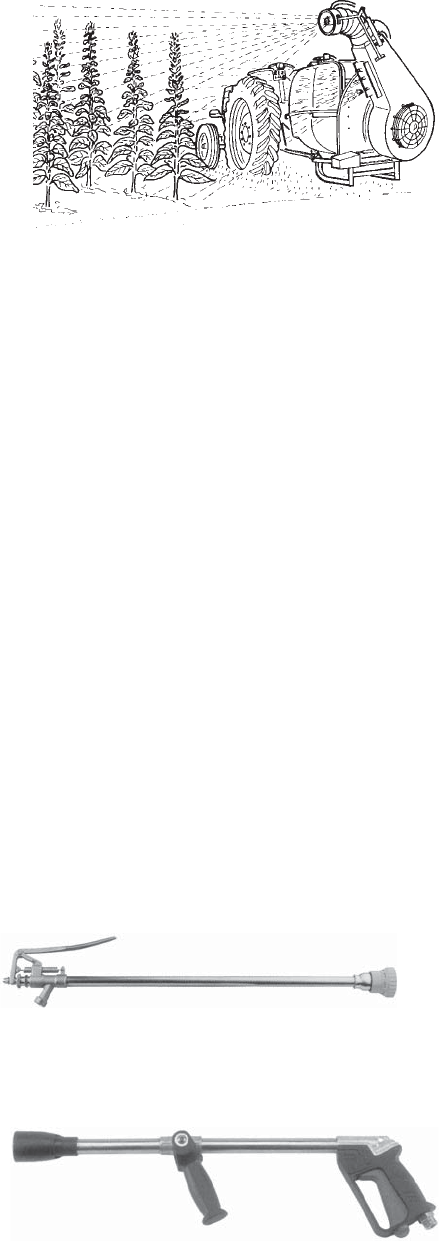
unigreen 21
6.4 CALIBRATING CANNON ATOMISERS
( Tables on pages 31-33 )
Atomisers with a cannon blower group are mainly intended for treating forest
trees or other tall plants that it is impossible to drive into with the sprayer (for
example tobacco or similar cultivations). They are also frequently used in
cultivation under mobile greenhouses.
When shooting the atomised chemical mix at distances, that can even be over
40 m, it isn’t possible to verify with the exact distribution on the area treated.
Due to the effect of the wind, the presence of turbulence and the obstacle of
the same plants being treated, we don’t recommend using cannons with
chemical products that need to be distributed with great precision.
Don’t use herbicides or similar products.
6.4.1 TREATMENTS ON TALL PLANTS
a) Use the tables of pages 31-33 choosing the one relevant to the type of
cannon to use and the number of jets.
b) On the last line choose the delivery in L/minute that goes with the chosen
working pressure.
c) Then spray the litres desired on the plant defining the necessary treatment
time.
When treating a poplar grove or in similar situation there are photocells for the
automatic management of the opening of the jet in the presence of the plant to
treat, available on request.
6.4.2 TREATMENTS ON HERBACEOUS CULTIVATIONS
a) Use the tables of pages 31-33 choosing the one relevant to the type of
cannon to use and the number of jets.
b) Find the range and the diameter of the nozzles used (ceramic plate or TR
nozzles).
c) In the horizontal strip, choose the working speed and the distribution in litres/
hectare and on the vertical scale find the pressure to use.
d) Adjust the pressure to obtain the treatment required.
Note: the minimum range indicated in the table can vary significantly
according to the adjustment of the single jets (screwed in more or less).
To verify the exact delivery of the fan do tests with clean water.
7 HAND LANCES
When using hand lances bear in mind the following notes:
= Don’t direct the jet of liquid towards electric power lines or zones where
there is electrical current, houses or where people might pass.
= Don’t point the jet at people or animals.
The jet can cause serious injuries simply due to the mechanical force of the
liquid under pressure.
= Never block the spraying lever of the lance in an open position because if
the lance falls it will be uncontrollable.
= At the end of work after you have stopped the pump, make sure that any
residual pressure in the pipes under pressure has been drained to avoid
unexpected jets when putting the lance away.
There are various types of lances; with a lever, mitra spray gun and pistol grip.
For further information please refer to the handbook in the package.
The lever lance is controlled by opening lever A which, depending on how much
it’s pressed, produces a conical spray or direct jet. The standard nozzle is Ø
1.5
The mitra spray gun can produce a direct jet or a conical spray and the type of
spray is selected by pushing lever B forwards or backwards. Use lever C to
open the jet. The standard nozzle is Ø 2.5
Replacement nozzles are available for all of the lances and the capacities are
indicated in the tables TAB.4 and TAB.5 ( page 35).
C
B
A
FIG. 22


















